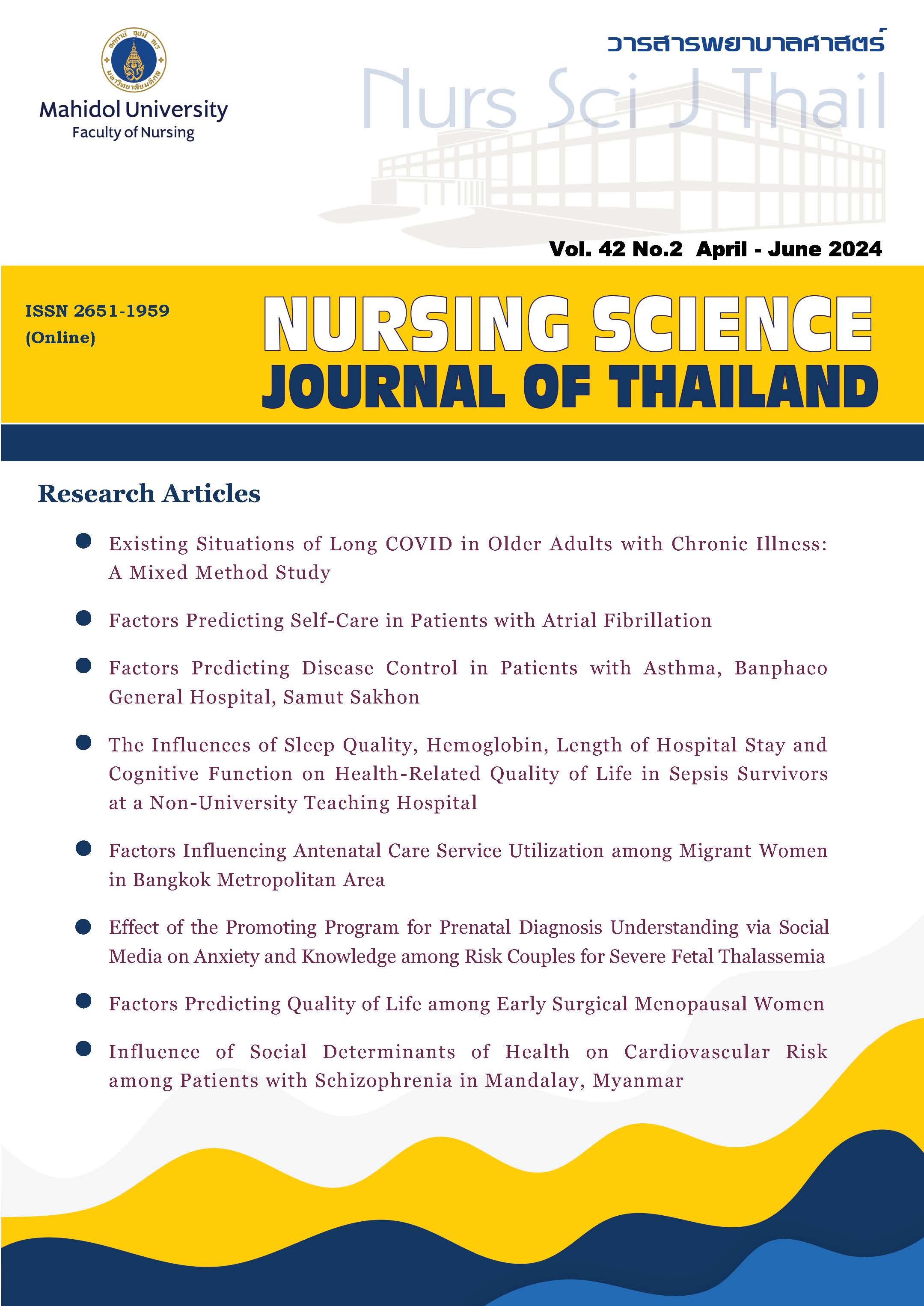อิทธิพลของปัจจัยสังคมกำหนดสุขภาพที่มีต่อความเสี่ยงในการเกิดโรคหัวใจและหลอดเลือดในผู้ป่วยโรคจิตเภท เมืองมัณฑะเลย์ ประเทศเมียนมาร์
Main Article Content
บทคัดย่อ
วัตถุประสงค์: เพื่อศึกษาอิทธิพลของปัจจัยสังคมกำหนดสุขภาพที่มีต่อความเสี่ยงในการเกิดโรคหัวใจและหลอดเลือดในผู้ป่วยโรคจิตเภท
รูปแบบการวิจัย: การศึกษาความสัมพันธ์เชิงทำนาย
วิธีดำเนินการวิจัย: กลุ่มตัวอย่างมีจำนวน 145 ราย เป็นผู้ป่วยโรคจิตเภท คัดเลือกกลุ่มตัวอย่างด้วยวิธีแบบสะดวกจากแผนกผู้ป่วยนอก โรงพยาบาลจิตเวช เมืองมัณฑะเลย์ ประเทศเมียนมาร์ เก็บข้อมูลโดยใช้แบบสอบถาม 1) ข้อมูลส่วนบุคคลและปัจจัยสังคมกำหนดสุขภาพ 2) แบบประเมิน CV RISK วิเคราะห์ข้อมูลโดยใช้สถิติเชิงพรรณนา และสถิติถดถอยสถิติถดถอยเชิงเส้น
ผลการวิจัย: ผลการวิจัยพบว่ากลุ่มตัวอย่างร้อยละ 6.3 มีความเสี่ยงในการเกิดโรคหัวใจและหลอดเลือด ปัจจัยทั้งหมด ได้แก่ ระดับการศึกษา รายได้ การจ้างงาน สถานภาพสมรส การสนับสนุนจากครอบครัว ยารักษาโรคจิต ระยะเวลาการป่วย และที่อยู่อาศัย สามารถร่วมกันอธิบายความแปรปรวนของความเสี่ยงในการเกิดโรคหัวใจและหลอดเลือดได้ร้อยละ 18 (R2 = .18, F(8, 136) = 3.82, p < .001) ที่อยู่อาศัย ระยะเวลาการป่วย และการจ้างงานเป็นปัจจัยที่มีอิทธิพลต่อการเกิดความเสี่ยงในการเกิดโรคหัวใจและหลอดเลือด ( = .31, p < .001;
= .22, p = .007;
= .16, p = .050 ตามลำดับ)
สรุปและข้อเสนอแนะ: ปัจจัยสังคมกำหนดสุขภาพ ประกอบด้วย ที่อยู่อาศัย ระยะเวลาการป่วย และการจ้างงานเป็นปัจจัยที่มีอิทธิพลต่อการเกิดความเสี่ยงในการเกิดโรคหัวใจและหลอดเลือดในผู้ป่วยจิตเภท ดังนั้น พยาบาลจิตเวชควรจัดให้มีระบบการคัดกรองความเสี่ยงในการเกิดโรคหัวใจและหลอดเลือดตั้งแต่ผู้ป่วยได้รับการวินิจฉัยว่าเป็นโรคจิตเภท และจัดทำโครงการส่งเสริมการจ้างงาน การมีกิจกรรมทางกายเพื่อป้องกันการเกิดโรคหัวใจและหลอดเลือดโดยเฉพาะกับผู้ป่วยจิตเภทที่มีภาวะว่างงาน มีระยะเวลาป่วยนาน และอาศัยอยู่ในชนบท
Article Details

อนุญาตภายใต้เงื่อนไข Creative Commons Attribution-NonCommercial-NoDerivatives 4.0 International License.
ลิขสิทธิ์: วารสารพยาบาลศาสตร์เป็นเจ้าของลิขสิทธิ์ในการเผยแพร่ผลงานที่ตีพิมพ์ ห้ามผู้ใดนำบทความที่ได้รับการตีพิมพ์ในวารสารพยาบาลศาสตร์ไปเผยแพร่ในลักษณะต่างๆ ดังต่อไปนี้ การส่งบทความไปตีพิมพ์เผยแพร่ที่อื่น การนำบทความเผยแพร่ออนไลน์ การถ่ายเอกสารบทความเพื่อกิจกรรมที่ไม่ใช่การเรียนการสอน ยกเว้นเสียแต่ได้รับอนุญาตจากวารสารพยาบาลศาสตร์

Disclaimer: เนื้อหาบทความหรือข้อคิดเห็นใดๆ ในวารสารพยาบาลศาสตร์ ถือเป็นความรับผิดชอบของผู้เขียน กองบรรณาธิการไม่จำเป็นต้องเห็นด้วยและไม่มีส่วนรับผิดชอบแต่อย่างใด
เอกสารอ้างอิง
Correll CU, Solmi M, Veronese N, Bortolato B, Rosson S, Santonastaso P, et al. Prevalence, incidence and mortality from cardiovascular disease in patients with pooled and specific severe mental illness: a large‐scale meta‐analysis of 3,211,768 patients and 113,383,368 controls. World Psychiatry. 2017;16(2):163-80. doi: 10.1002/wps.20420.
Ratna VVJ, Vempadapu M, Kolakota RK, Mugada V. Risk of cardiovascular disease in schizophrenia: a mini review. Asian Journal of Research in Pharmaceutical Science. 2019;9(2):131-6. doi: 10.5958/2231-5659.2019.00019.5.
Correll CU, Ng-Mak DS, Stafkey-Mailey D, Farrelly E, Rajagopalan K, Loebel A. Cardiometabolic comorbidities, readmission, and costs in schizophrenia and bipolar disorder: a real-world analysis. Ann Gen Psychiatry. 2017;16:9. doi: 10.1186/s12991-017-0133-7.
Kapıcı Y, Güc B, Tekin A, Abuş S. The relationship of ten-year cardiovascular disease risk and clinical features in patients with schizophrenia. Noro Psikiyatr Ars. 2023;60(3):231-5. doi: 10.29399/npa.28292.
Saldanha NC, Balasundaram S, Sarkar S, Hanifah M. Prevalence and correlates of metabolic syndrome among psychiatric inpatients at a tertiary care center. Telangana Journal of Psychiatry. 2021;7(2):114-21. doi: 10.4103/tjp.tjp_33_21.
Jahrami HA, Faris MAE, Saif ZQ, Hammad LH. Assessing dietary and lifestyle risk factors and their associations with disease comorbidities among patients with schizophrenia: a case–control study from Bahrain. Asian J Psychiatr. 2017;28:115-23. doi: 10.1016/j.ajp.2017.03.036.
Asaye S, Bekele S, Tolessa D, Cheneke W. Metabolic syndrome and associated factors among psychiatric patients in Jimma University Specialized Hospital, South West Ethiopia. Diabetes Metab Syndr. 2018;12(5):753-60. doi: 10.1016/j.dsx.2018.04.037.
Odeigah LO, Agede OA, Ogunjemilua SB, Obalowu IA, Mutalub YB. Interplay between lipid profile and weight-related outcomes in healthy overweight adults: in-sights from comprehensive analyses. Pan Afri J Life Sci. 2023;7(2):676-81. doi: 10.36108/pajols/3202/70.0270.
Bailey JM, Wye PM, Wiggers JH, Bartlem KM, Bowman JAJPmr. Family carers: a role in addressing chronic disease risk behaviours for people with a mental illness? Prev Med Rep. 2017;7:140-6. doi: 10.1016/j.pmedr.2017.05.014.
World Health Organization. Non-communicable diseases country profile 2018. Geneva: World Health Organization; 2018. 223 p.
Healthy People 2020: Social determinants of health [Internet]. Washington, DC: Office of Disease Prevention and Health Promotion. [updated 2022] Available from: https://www.healthypeople.gov/2020/topics-objectives/topic/social-determinants-of-health.
Krisberg K. Shift toward social determinants transforming public health work: targeting causes of health disparities. The Nation's Health. 2016;46(5):1-21.
Evason N. Myanmar (Burmese) culture [Internet]. The Cultural Atlas; 2017. Available from: https://culturalatlas.sbs.com.au/myanmar-burmese-culture/burmese-myanmar-culture-family.
Central Statistical Organization, UNDP, World Bank. Myanmar living condition survey 2017: key indicators report. 2nd ed. Nay Pyi Taw and Yangon, Myanmar: Ministry of Planning and Finance, UNDP and World Bank. 2018. 188 p.
Zdrenghea D, Guşetu G, Zdrenghea M, Cismaru G, Caloian B, Vaidean G, et al. CV RISK– A new relative cardiovascular risk score. Med Hypotheses. 2019;132:109362. doi: 10.1016/j.mehy.2019.109362.
SPSS Inc. PASW Statistics for Windows, version 18.0. Chicago, IL: SPSS Inc.; 2009.
Haddad C, Hallit S, Salameh P, Bou-Assi T, Zoghbi M. Coronary heart disease risk in patients with schizophrenia: a Lebanese cross-sectional study. J Comorb. 2017;7(1):79-88. doi: 10.15256/joc.2017.7.107.
Rossom R, Hooker S, O’Connor P, Crain A, Sperl-Hillen J. Cardiovascular risk for patients with and without schizophrenia, schizoaffective disorder, or bipolar disorder. J Am Heart Assoc. 2022;11:e021444. doi: 10.1161/JAHA.121.021444.
Jeemon P, Harikrishnan S, Ganapathi S, Sivasankaran S, Binukumar B, Padmanabhan S, et al. Efficacy of a family-based cardiovascular risk reduction intervention in individuals with a family history of premature coronary heart disease in India (PROLIFIC): an open-label, single-centre, cluster randomised controlled trial. Lancet Glob Health. 2021;9(10):e1442-50. doi: 10.1016/S2214-109X(21)00319-3.
Aye SKK, Hlaing HH, Htay SS, Cumming R. Multimorbidity and health seeking behaviours among older people in Myanmar: a community survey. PLoS One. 2019;14(7):e0219543. doi: 10.1371/journal.pone.0219543.
Saw YM, Than TM, Thaung Y, Aung S, Shiao LW-S, Win EM, et al. Myanmar's human resources for health: current situation and its challenges. Heliyon. 2019;5(3):e01390. doi: 10.1016/j.heliyon.2019.e01390.
Lin K, Lin S, Sein TT. The challenges faced by service providers on satellite mental health-care facilities in Yangon, Myanmar: a qualitative study. J Health Res. 2020;36(1):89-98. doi: 10.1108/JHR-02-2020-0029.
Kumari S, Dahuja S, Singh U. Association of clinical factors with socio-occupational functioning among individuals with schizophrenia. Ind Psychiatry J. 2023;32(1):65-70. doi: 10.4103/ipj.ipj_141_20.
Algren MH, Ekholm O, Nielsen L, Ersbøll AK, Bak CK, Andersen PT. Associations between perceived stress, socioeconomic status, and health-risk behaviour in deprived neighbourhoods in Denmark: a cross-sectional study. BMC Public Health. 2018;18(1):250. doi: 10.1186/s12889-018-5170-x.


